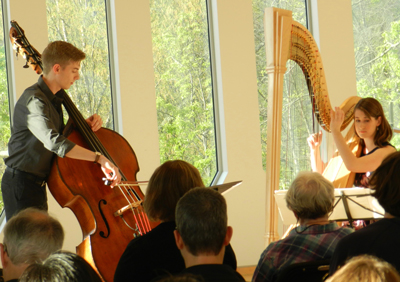by Mike Telin

“We have been so apologetic in this, what we call classical music, that we say: ‘You don’t have to know anything, you don’t have to have any background, you don’t have to have any frame of reference, just come with an open mind, and you’ll love it,’” Salonen said during the interview. “It doesn’t quite work like that. Because if I go to an American football game not knowing anything about the rules — as, I have to admit, I don’t — it’s totally meaningless.”
On Sunday, May 15 at 5:00 pm at St. John’s Episcopal Church in Ohio City, the Syndicate for the New Arts will present a concert featuring five world premieres of works that explore the sonic possibilities of the double bass and harp. Immediately following the performance, harpist Caitlin Mehrtens and bassist Austin Lewellen will join composers Sage Jenson, Judy Jackson, Jonah Haven, Gregory Manuel, and Joshua Rosner for a discussion moderated by myself. The session will be an opportunity for everyone to gain an understanding of the “rules of the game.” Questions such as, “How did you do that?” or “Why did you do that?” or “Couldn’t it have been done another way?” are encouraged.
During an open rehearsal yesterday at St. John’s, the duo ironed out some spots in Rosner’s transcendental etude. The work highlights some idiosyncrasies of both instruments when they’re juxtaposed. “How quickly can you change the pedal here?” Rosner asked Mehrtens, pointing to a bar in the score. Hearing that question was a reminder that writing for the harp is a complicated process.
Rosner’s piece is full of meter changes, and afterwards I asked why he didn’t write it in a consistent time signature. “I could have, but it would have lost some of its swing,” he pointed out.
Of the five works commissioned by Mehrtens and Lewellen, only two are in standard notation. “We specifically asked Judy Jackson for a concept score,” Lewellen said, showing me a stack of small cards. Some of them contained written instructions, others only small drawings — for example of a bird. “We received a wide variety of scores: they all look so different physically, and are notated very differently.”
Concluding our conversation, I asked the duo why the two instruments work so well together. Mehrtens and Lewellen agree that it is because the harp and the bass have very wide ranges, especially in the lower register. “They also blend together really well,” Mehrtens said. “And because of the wide range,” Lewellen added, “there’s a lot of room for us to get out of each other’s way.”
An avid interpreter of new music, Austin Lewellen regularly collaborates with many composers. This past September, Austin worked with composer Beat Furrer as a stipendiat of the Internationale Ensemble Modern Akademie program at Klangspuren Schwaz, Germany.
Caitlin Mehrtens, Outreach Director for the Syndicate for the New Arts, has not only enjoyed performing new music, but also creating partnerships with other artists and organizations in the greater Cleveland area that will grow the community surrounding new art. She has toured, premiered, and recorded multiple works with Oberlin’s Contemporary Music Ensemble, and also performed numerous times as a concerto soloist with a variety of orchestras, most recently with the Akademisches Orchester at the Gewandhaus in Leipzig, Germany.
Published on ClevelandClassical.com May 11, 2016.
Click here for a printable copy of this article



